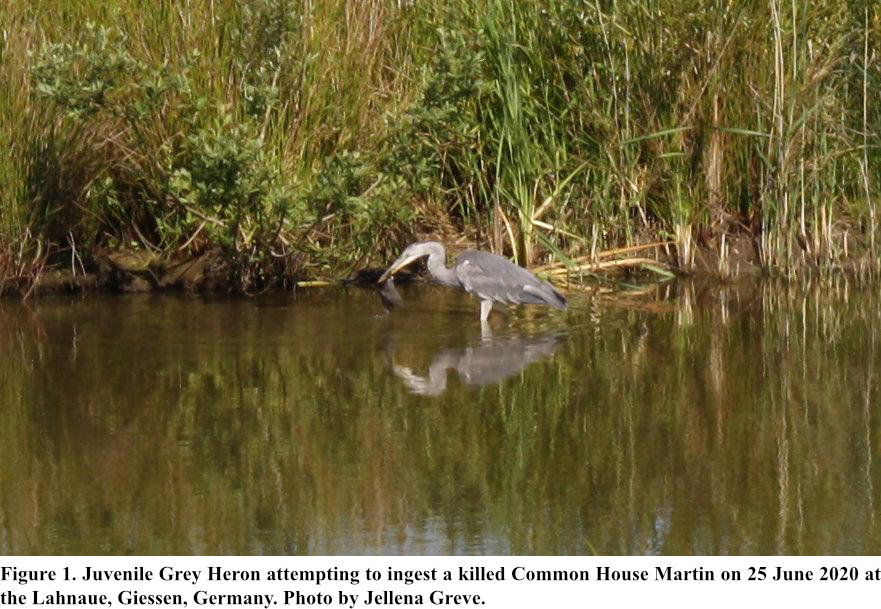Opportunistic killing and partial predation of a Common House Martin (Delichon urbicum) by a Grey Heron (Ardea cinerea)
Abstract
In this short communication, we provide the first documented predation event involving the opportunistic killing of a Common House Martin (Delichon urbicum) by a juvenile Grey Heron (Ardea cinerea) in a small pond close to urban areas of Giessen, in Hessen, central Germany. In addition, we review previous literature records documenting the killing and predation of avian species by the Grey Heron.
Key words: Common House Martin, juvenile Grey Heron, surplus killing, rare predation event.
Introduction
The Grey Heron (Ardea cinerea) represents a widespread and overall common member of the family Ardeidae (Kushlan and Hancock 2005), inhabiting a diverse range of aquatic habitats. This species occasionally penetrates into semi-arid and non-freshwater habitats and tolerates habitat modifications and environmental changes, which results in frequent encounters in suburban areas close to human settlements (Cramp and Simmons 1988, Bauer et al. 2005, Kushlan and Hancock 2005). It was frequently observed in locations within Giessen’s interior and peripheric parts in Hessen, Central Germany (Gebhardt and Sunkel 1954), nesting and foraging in parks and ponds in adjacent areas of the city (VM, pers. obs.). Here we provide a qualitative description of a rare predation event, with the first documented killing and only partial predation of a Common House Martin (Delichon urbicum) by a Grey Heron.
Observations and Discussion
On 25 June 2020, we observed a rare predation event along a small pond located in Lahnaue, Giessen, Germany (50° 34′ 13.73″ N, 8° 35′ 54.66″ E). Between one to two Grey Herons were consistently present during our observation period (0730-1140 h), with one juvenile Grey Heron observed to forage at the site from the dawn period (0730 h), simultaneously with recorded preying on a European Tree Frog (Hyla arborea) and the presence of flocks of Common House Martins, Barn Swallows (Hirundo rustica) and Common Swifts (Apus apus) hawking over the water surface for insects.
We observed the following activities from the side of the pond, c. 30 m away from the waterfront using a single spotting scope (20-60 x 80) and binoculars (10-22 x 50).
The juvenile Grey Heron, after preying on a European Tree Frog around 0813 h, pursued its foraging activities after a short period of inactivity. Around 0934 h, a single Common House Martin perched in a dense, nearby reed bed (c. 1 m inter-individual distance) to the Grey Heron. Around 0937 h, we noticed that the Grey Heron changed its route and detected the Common House Martin moving slowly towards it. As the Common House Martin faced the opposite direction, surrounded by dense vegetation, we assume that it was unable to track the movement of the Grey Heron. Once the inter-individual distance was <10 cm, the Grey Heron performed a sudden strike towards the resting Common House Martin, before it could take off or notice the Grey Heron. While we could not identify any external injuries through the spotting scope, the behavior indicated that the initial attack was critical (the Common House Martin fell instantly into the water, being incapacitated to take off). Around 0941 h, the Grey Heron repeatedly grabbed the Common House Martin, evidently killing it (Fig. 1). However, the Common House Martin was not eaten, even though we observed several unsuccessful attempts at ingestion during 15 min. The Grey Heron then moved to another area of the pond. After that we kept observing the Grey Heron for approximately another 35 min and did not see any further interactions – the predated Common House Martin was left in the water, while the Grey Heron disappeared and departed towards the Dutenhofer Lake.

These observations probably represent the first confirmed case of opportunistic killing and partial predation of a Common House Martin by a Grey Heron. Previous records highlighted predation attempts involving the Grey Heron and swallows (Hirundo spp.), documenting aerial lunging and the attempt of capturing them in flight (Keighley and Hall 1995). Additionally, the predation of very agile flyers like the Little Swifts (Apus affinis) was previously documented (Power 2013, Piñeiro 2023). However, we were unable to confirm the ingestion of the swallow through our direct observation. As Grey Herons are known to prey on medium-sized waterbirds, we can exclude physical constraints as the proximal cause to interpret the outcome of the predation event. In comparison to the average size of a Common House Martin of c. 13 cm (Bauer et al. 2005), Grey Herons were recorded consuming a 30 cm carp weighing 475 g, and 57 cm eels (Moser 1986) – assuming that size was not a proximate constraint here. Based on literature records, the direct predation on flying birds seems in general to be either a rare phenomenon, probably by the fact that the likelihood of capturing a bird in flight or while perched is considerably low.
In general, the predation of avian species by the Grey Heron is not uncommon, however, most common avian prey consists of flightless young of waterbirds, like chicks of the Cape Cormorant (Phalacrocorax capensis; Williams and Ward 2006), Northern Lapwing (Vanellus vanellus), Black-tailed Godwit (Limosa limosa; Teunissen et al. 2008), Mallard (Anas platyrhynchos) and Tufted Duck (Aythya fuligula; Marquiss and Leitch 1990). Lowe (1954) also listed the chicks of ‘tern’ and ‘lesser blackbacks and herring-gulls’, and the young of ‘mallard, moorhen and other waterfowl’ and ‘heron’. Records of flying avian prey species in contrast remaining scarce, consisting of singular observations of Grey Herons predating on: the Common Kingfisher (Alcedo atthis; Sparks 2002), Blue-eared Kingfisher (Alcedo meninting; Khoo 2020), Tree Pipit (Anthus trivialis), Eurasian Hoopoe (Upupa epops; Greaves 1991), Common Blackbird (Turdus melura; Batty and Forbes 1997) and Common Starling (Sturnus vulgaris; Bowey 1997), along waterbirds such as the Little Grebe (Tachybaptus ruficollis; McCanch 2003), Great Crested Grebe (Podiceps cristatus; Kreuziger and Achenbach 1998), Common Redshank (Tringa totanus; Greaves 1991), Water Rail (Rallus aquaticus; Murphy 1976), ‘moorhens’ and ‘snipe’ (Lowe 1954). Based on stomach contents and pellets, Lowe (1954) also recorded ‘wood-pigeon’, ‘sparrow’, ‘blackbird’, ‘robin’, ‘starling’ and ‘dabchick’ among the prey. Further observations and unpublished records on this certain subject would be an interesting addition to the foraging ecology and prey selection to understand the behavioral plasticity in foraging of the species.
After killing the prey, the Grey Heron ceased the ingestion attempt and left the prey without any further interaction. The proximate cause for the vanishing interest remains on the first sight unclear, as neither external disturbance was present that could explain the behavior of the Grey Heron nor any indication that the Grey Heron struggled to swallow the prey. Also, the misidentification of prey from such a short distance seems implausible. However, it is known that Grey Herons sometimes do not ingest even common prey after killing it - in particular that behavior seems to occur in juvenile Grey Herons (K. Matsunaga, pers. comm.). Considering that juvenile Grey Herons might need to practice acquiring the full suite of hunting behaviors, our observation insinuates that such “surplus killing" could be used to improve capturing and killing prey more efficiently. Here, the killing of the prey presumably not targets the ingestion but rather to enhance the capture rate and hunting success. While surplus killing is well-documented in mammals (Hansen 2006, Appleby and Smith 2018), it has also been observed in birds, especially in raptors (Shrubb 1982), but not been observed in waterbirds. It seems plausible that from an ethological context, opportunistic killing might occur in young individuals that are lacking in hunting experience. Nonetheless, this aspect of foraging behavior remains poorly known and further investigations would represent a desirable research topic.
Acknowledgements
We would like to thank the faculty staff of the Biology Department at the Justus-Liebig-University in Giessen for organizing the field trip to the Lahnaue and providing us with the equipment as part of the nature conservation course. We would like to thank the reviewer comments of Katsutoshi Matsunaga and Chip Weseloh that improved the quality of the manuscript.
Literature Cited
Appleby, R. G. and B. P. Smith. 2018. Do wild canids kill for fun? Pages 181-209 in Wild Animals and Leisure (N. Carr and J. Young, eds.). Routledge, Abingdon-on-Thames, U.K.
Batty, R. E. and L. Forbes. 1997. Grey Heron catching and swallowing Blackbird. British Birds 90: 112.
Bauer, H. G., E. Bezzel and W. Fiedler. 2005. Das Kompendium der Vögel Mitteleuropas. Band II Passeriformes-Sperlingsvögel. Aula-Verlag, Wiebelsheim, Germany.
Bowey, K. 1997. Grey Heron catching Common Starling in flight. British Birds 90: 112-113.
Cramp, S. and K. E. Simmons. 1988. Birds of Europe, the Middle East and North Africa. Oxford University Press, Oxford, U.K.
Gebhardt, L. and W. Sunkel. 1954. Die Vögel Hessens. Verlag Waldemar Kramer. Frankfurt am Main, Germany.
Greaves, C. 1991. Grey Heron catching, killing and swallowing Hoopoe. British Birds 84: 57-58.
Hansen, K. 2006. Bobcat: Master of survival. Oxford University Press, New York, U.S.A.
Keighley, M. and A. Hall. 1995. Grey Heron capturing hirundine in flight. British Birds 88: 423.
Khoo, C. 2020. Grey Heron preying on a Blue-eared Kingfisher. Singapore Bird Group. [online] Accessed 12 December 2024.
Kreuziger, J. and E. L. Achenbach. 1998. Grey Heron Ardea cinerea swallows a juvenile Crested Grebe Podiceps cristatus. Vogelwarte 39: 301-301.
Kushlan, J. A. and J. A. Hancock. 2005. The herons. Oxford University Press, Oxford, U.K.
Lowe, F. 1954. The heron. Collins, London, U.K.
Marquiss, M. and A. F. Leitch. 1990. The diet of Grey Herons Ardea cinerea breeding at Loch Leven, Scotland, and the importance of their predation on ducklings. Ibis 132: 535-549.
McCanch, N. 2003. Grey Heron choking on Little Grebe. British Birds 96: 86.
Moser, M. E. 1986. Prey profitability for adult Grey Herons Ardea cinerea and the constraints on prey size when feeding young nestlings. Ibis 128: 392-405.
Murphy C. M. 1976. Grey Herons eating Water Rails. British Birds 69: 369.
Piñeiro, X. 2023. Grey Herons Ardea cinerea hunting and eating Little Swifts Apus affinis. Biodiversity Observations 13: 204-205.
Power, R. J. 2013. Grey Heron Ardea cinerea “spearfishing” swifts? Biodiversity Observations 2013: 4-5.
Shrubb, M. 1982. The hunting behaviour of some farmland Kestrels. Bird Study 29: 121-128.
Sparks, J. 2002. Grey Heron preying on Rabbit and Common Kingfisher. British Birds 95: 85.
Teunissen, W., H. Schekkerman, F. Willems and F. Majoor. 2008. Identifying predators of eggs and chicks of Lapwing Vanellus vanellus and Black-tailed Godwit Limosa limosa in the Netherlands and the importance of predation on wader reproductive output. Ibis 150: 74-85.
Williams, A. J. and V. L. Ward. 2006. Sacred Ibis and Gray Heron predation of Cape Cormorant eggs and chicks; and a review of Ciconiiform birds as seabird predators. Waterbirds 29: 321-327.



